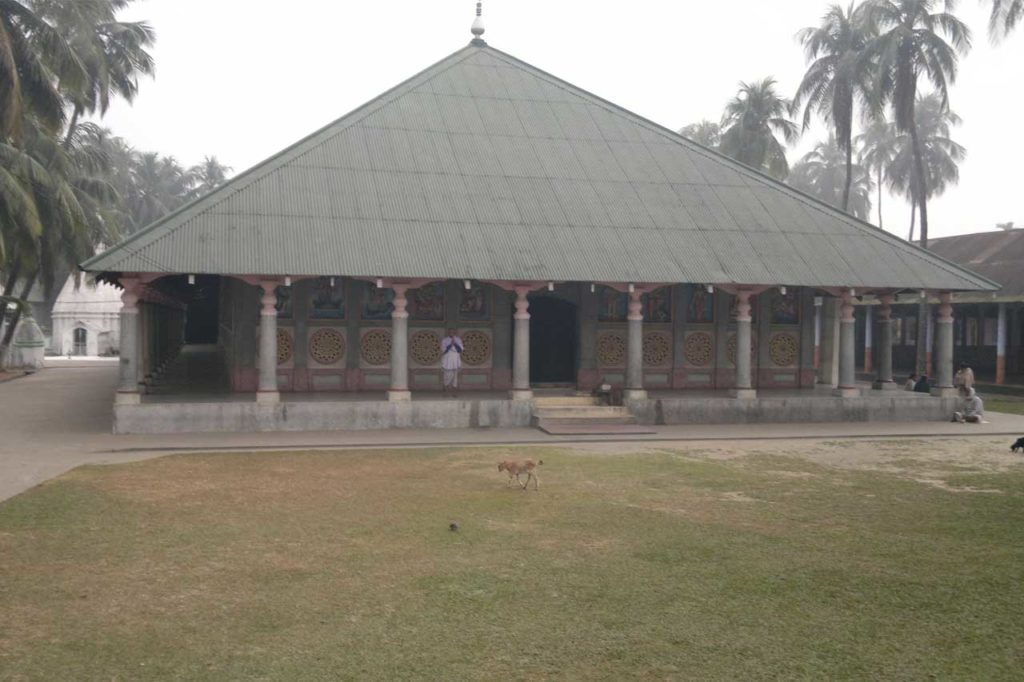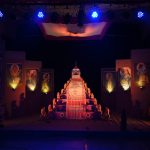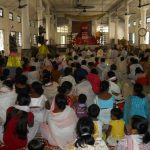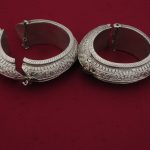Madhavadeva’s father Govinda Bhuyan was an accountant of Pratap Rai, the king of Banduka, presently in Rangpur district of Bangladesh. Forefather of Govinda had earlier migrated from Kannauj along with other Bhuyans. Govinda married a girl named Anuchita in Banduka. Anuchita died at an early age leaving an infant son, Damodar. When Damodar grew up, Govinda transferred his office to Damodar and set out for upper Assam with some merchandise. He reached Tembuwani and was glad to find the Bhuyans residing there. Srimanta Sankaradeva persuaded him to marry again and arranged a match with his cousin Manorama. Srimanta Sankaradeva also appointed Govinda as ‘Bora’ or a revenue officer of the Bhuyan kingdom at Rowta.
A terrible attack by the Bhutiyas towards the end of 1488 AD made Govinda and Manorama completely broke. Manorama was then five months pregnant. When the couple tried to escape from the place in a Pâlanquin, they were robbed by the carriers themselves. However luck was in their favour. They were rescued by Harisinga Bora, an Uzir of the Ahom administration, who took them to his house.
Harisinga Bora treated Govinda and Manorama as his own parents and put them up in his residence at Rangajan in Narayanpur. It was there that Madhavadeva was born on 1st Jeth of 1411 Sakâbda (May, 1489). As Madhavadeva grew up, he began to assist Harisinga in tax collection works. Govinda and his family left Narayanpur in 1503 and started to live at Ghagar, under the care of Govinda Majhi. Manorama gave birth to her second child, Urvashi there. About fourteen years passed and Urvashi grew up to a fine lady. However there was no Bhuyan family in the vicinity to seek alliance for her. So Govinda left Ghagar and married off Urvashi to Ramdas alias Gayapani at Bhararidubi.
After the marriage was solemnized, Govinda and Madhavadeva set out for Banduka, leaving Manorama with Urvashi and Ramdas at Bhararidubi. Madhavadeva met his elder brother Damodar for the first time at Banduka. Damodar arranged for his education under Rajendra Adhyapaka, a reputed scholar. Within a short time, Madhavadeva mastered all the scriptures of Sanâtana Hindu religion. Then he learnt accountancy too, since it was their family trade. Madhavadeva proved his genius by completing both academic as well as professional training in a short period of just three years.
Madhavadeva and Govinda were preparing to return to Assam after three and a half years of stay in Banduka, when Govinda passed away suddenly. When Madhavadeva eventually returned to Assam, he was informed on the way that his mother was lying critically ill. Thereupon he mentally dedicated a pair of he-goats to goddess Durga, seeking recovery of his mother. Thereafter the events took him to Srimanta Sankaradeva and he embraced Eka Sarana Nâma Dharma. Once he surrendered himself completely at the lotus-feet of Srimanta Sankaradeva, he shifted permanently to Dhuwahata leaving his mother in the care of Ramdas and Urvashi. He gave up all his worldly possessions and started living like a renouncee. His mother had performed Joron (presentation of jewellery) ceremony with a girl from Negheriting with a view to bring her as daughter-in-law and gifted the customary gold jewellery. Madhavadeva came out of that alliance too. He returned from the thresh-hold of married life.
Madhavadeva became a catalyst for Srimanta Sankaradeva. He even incorporated a fourth dimension in the Eka Sharana Nâma Dharma. He added the necessity of Guru (Preceptor) as the fourth cornerstone required to be followed by the devotees together with Deva (God), Nâma (Name) and Bhakata (Devotee). Accepting a person as one’s Guru enabled one to get over one’s ego, which was the biggest hurdle in the path of devotion. Guru represented God to a devotee. Madhavadeva knew all these things and hence he advised the incorporation of this element. Thus he began to act as an assistant of his Guru in all spheres.
Once Madhavadeva was arrested alogwith Srimanta Sankaradeva’s son-in-law Hari when the Bhuyans failed to guard the elephants they were entrusted with guarding during an elephant safari by the Ahom king. Hari was executed. Madhavadeva was kept under house arrest for six months in the Ahom capital before being acquitted. This made Srimanta Sankaradeva leave the Ahom kingdom. Madhavadeva took immense care of his Guru throughout the journey to Koch kingdom. He became friend with Narayandas Thakur, a great merchant, who took initiation under Srimanta Sankaradeva at Chunpora, their first place of stay in the Koch kingdom. From then onward Narayandas Thakur took all mundane responsibilities of Madhavadeva.
Madhavadeva went out of his way to serve his Guru, Srimanta Sankaradeva. He volunteered his service to fulfil the needs and requirements of Srimanta Sankaradeva. One evening in the Bhâda month of Assamese calendar, Madhavadeva learnt that Srimanta Sankaradeva did not have any change of cloth to wear in the next morning. The Guru had only two sets of clothes. He had washed one set in that evening as he had to take bath. The weather was cloudy and hence there was no chance of the wet clothes getting dried by the next morning. Madhavadeva set out for the house of Dibakar Maral, a weaver, after taking supper. Dibakar had been given yarn to prepare a third set of clothes for Srimanta Sankaradeva.
There was a heavy downpour that night and the roads were completely inundated. But Madhavadeva did not care for that. He had to walk through chaste-deep water in some places. Not only that, he even avoided the safe land route and instead travelled through the fields and jungles in order to reach early. His body was scratched by thorns; the leeches sucked blood from him. But he was not dissuaded. Eventually he reached Dibakar’s house after three hours. Dibakar bathed him and gave him a new change of cloth to wear. Madhavadeva returned to Patbausi after collecting the clothes from Dibakar. He presented those to Srimanta Sankaradeva when the latter just completed his bath and started mopping water from his body.
Srimanta Sankaradeva set out for his second pilgrimage in 1550. Madhavadeva took all care of his Guru during this trip. He washed the feet of Srimanta Sankaradeva when those suffered from day-long walk in the Sun. He would arrange provisions for Guru as well as the fellow pilgrims and assist his Guru in cooking food. Only after that he would cook his own food. Whenever any adverse situation arose, Madhavadeva took the first step to solve it.
Srimanta Sankaradeva had composed two hundred and forty Bargeets in his inimitable style. These songs were sung by the devotees as part of their prayer sessions and also as item of cultural entertainment. Once a devotee named Kamala Gayan took the manuscript of Bargeets to his house for memorizing. A forest fire ravaged Patbausi that very year during the Chat (March-April) month. Kamala’s house was engulfed by that devastating fire. With that, the manuscript of Bargeets also was burnt to ashes. Srimanta Sankaradeva was upset by this unfortunate incident. He asked Madhavadeva to compose some songs. Actually Madhavadeva had been composing Bargeets even before that. Even during the second pilgrimage Srimanta Sankaradeva quite often asked his favourite disciple to come up with the latter’s own composition, whenever he came across any penegyrist from other sects. Madhavadeva was an expert composer of not only Bargeet, but also of Bhatimâ and other verses.
Madhavadeva tried his best to jot down the verses of Srimanta Sankaradeva, which some or other devotees had memorized already. This way he recovered thirty four Bargeets composed by Srimanta Sankaradeva fully. Next, he tried to recover the scattered parts of the remaining songs. He went on to embellish those parts with his own compositions so as to make complete songs out of them. In total, one hundred ninety one Bargeets are now available between Srimanta Sankaradeva and Madhavadeva.
Srimanta Sankaradeva gave yet another important responsibility to Madhavadeva. It was the task of translating the first canto of the epic, Râmâyana. Srimanta Sankaradeva and Madhavadeva were editing the Assamese translation of Râmâyana, which had been originally rendered into Assamese by Madhava Kandali, a reputed poet of yesteryears. Srimanta Sankaradeva and Madhavadeva carried out this editing in order to save the valuable work of Madhava Kandali from being plagiarized by a contemporary author. But Madhava Kandali had translated only five cantos of Râmâyana. So Srimanta Sankaradeva decided to render the remaining two cantos also. He translated the last canto, while the first canto was translated by Madhavadeva. It is called Adikânda Râmâyana.
In the early part of 1568, Srimanta Sankaradeva came over to Bhela permanently to spend the remaining days of his life there. Before that, he settled the issue of succession in the order as his disciples had started worrying about it. The Eka Sharana Nâma Dharma had already been established as an important religious belief and the number of believers also increased by leaps and bounds. Srimanta Sankaradeva invited all his disciples living in the Brahmaputra valley to Patbausi. He entrusted the responsibility of leading the order upon Madhavadeva formally in that congregation by putting a garland of holy Basil leaves on Madhavadeva’s head. Thus Madhavadeva was declared an Achârya as well as the over-all head of the order.
Madhavadeva was looking after the family of his preceptor, Srimanta Sankaradeva at Patbausi with great sincerity after the Guru’s demise. But some jealous persons made some derogatory comments on his involvement with a family full of women. The eldest son of Srimanta Sankaradeva, Ramananda also died in 1569 leaving his widow. The second son, Kamal Lochan had died earlier in 1561 leaving his widow. Madhavadeva was taking care of all these helpless women. But he was hurt by the cruel comments of his adversaries and therefore he shifted to Sundaridiya. He visited the family of his Gurudeva from there now and then. He translated the scripture Bhakti-Ratnâwali by Vishnupuri to Assamese. He also gave a systematic form to the prayer sessions of Eka Sharana Nâma Dharma and divided them into fourteen sessions to be perfomed at different times of the day. These are called Saidhya Prasanga.
The religious order Eka Sharana Nâma Dharma was not devoid of aesthatics. Both Srimanta Sankaradeva and Madhavadeva were great artists. They both composed many songs, dances, and plays. Madhavadeva sought to maintain the tradition of his Gurudeva and therefore constructed a beautiful Kirtanghar at Tantikuchi (Barpeta), where Srimanta Sankaradeva had prepared the famous Vrindavani cloth and woven the life and works of lord Krishna in fabric. This Kirtanghar, established by Madhavadeva in 1583, was beautified by elements like quartz, which glittered like gold. Religious festivals were held in this Kirtanghar. A lot of people started coming from far and wide. This made the adversaries very jealous. They gave allegation that Madhavadeva had decorated the Kirtanghar with gold and silver. They got a royal official, Surananda to check the Kirtanghar thoroughly. Surananda almost tore down the Kirtanghar. He also arrested the devotees on the false allegation of making young females act in the plays and dances. Actually all those actors and danceuses were boys, who played the roles of damsels. Surananda released the devotees only after extracting huge amount of ransom money from them. All these made Madhavadeva very sad. But he was not dissuaded from the mission entrusted upon him by Srimanta Sankaradeva. He gave Gopal, the fomer head weaver of Tantikuchi the responsibility of maintaining the Barpeta Kirtanghar. Gopal later became famous with the name of Mathuradas Burha Ata.
Madhavadeva travelled extensively to spread the message of Srimanta Sankaradeva. Many people got initiated in the Eka Sharana Nâma Dharma. This made a section of the elite class very jealous. They incited the local king, Raghu, who was son of Chilarai, fomer General of the undivided Koch kingdom, against Madhavadeva. These people got Madhavadeva banished to Hajo. But there too Madhavadeva became a centre of attraction. People visited him more than the famous Hayagriva Mâdhava Dewâlaya. This made the royal officials of Kochbehar sit up. Lakshminarayan was then the king of Koch kingdom. He was the son of Naranarayana, the fomer king of the undivided Koch kingdom. His administration invited Madhavadeva to their kingdom. Madhavadeva was glad to comply with that request. He immediately moved to Kochbehar. He built a Thân at Madhupur, a place earlier shown by Srimanta Sankaradeva as a holy spot. Over time it became a centre of pilgrimage for the followers of Eka Sarana Nâma Dharma.
Madhavadeva completed some pending works. Srimanta Sankaradeva had asked him to compile the hymns authored by him (Srimanta Sankaradeva) for prayer. Madhavadeva sent his nephew, Ramcharan Thakur to different places of the Brahmaputra valley to gather those hymns. Different chapters were lying with different devotees in different places. Ramcharan gathered all those by great effort and compiled those to a book. This book is known as Kirtana-ghoshâ. It is the most popular book in the Assamese language.
Madhavadeva also authored a book named Nâmghoshâ. He had been asked by Srimanta Sankaradeva to write that book, where a devotee would be able to find the gist of the Eka Sharana Nâma Dharma and also get help in developing devotion. Thus this book was to be a mixture of philosophy and devotion, which was a very difficult task. But Madhavadeva made that difficult task possible by his great intellect and devotion. Nâmghoshâ continues to attract the devotees even now with its deep philosophy and sweet devotional verses.
Srimanta Sankaradeva authored several plays in his life. Madhavadeva also followed in the footsteps of his Guru and composed several plays. Among all the direct disciples of Srimanta Sankaradeva, only Madhavadeva happened to be a playwright. So Madhavadeva could continue with the Ankiyâ play tradition initiated by his preceptor. But his plays were of a different genre and these were called Jhumurâ. He authored several plays like Arjuna bhanjana, Bhojana byavahâra, Chor dharâ, Pimparâ guchowâ, Bhumi lutiowâ, Râsa jhumurâ and Kotorâ khelowâ. He also authored two Kâvyas named Râjasuya and Janma rahasya on the instruction of Srimanta Sankaradeva.
Both Srimanta Sankaradeva and Madhavadeva were engaged in formulating a new pattern of music and dance, which they distanced carefully from other schools. There was an academic seriousness in them, which goaded them to compete with other classical schools of India. It became very distinct during the second pilgrimage of Srimanta Sankaradeva in 1550-51. Whenever a penegyrist from any other cult sang a hymn during that journey, Srimanta Sankaradeva would ask Madhavadeva to come out with the latter’s own rendering. Such encouragement worked wonder for Madhavadeva, who composed several beautiful songs. So the school of Sankari music is highly indebted to Madhavadeva for the nourishment in its formative years.
Madhavadeva had been a merchant till the time he met Srimanta Sankaradeva. But once Madhavadeva and Srimanta Sankaradeva came together, it was as if sparks flew. The multi-faceted talent of Madhavadeva came out only after he came in contact with Srimanta Sankaradeva, who brought out the best from Madhavadeva. Srimanta Sankaradeva was thus clearly a catalyst for Madhavadeva.
Madhavadeva had a good sense of history. He understood the importance of his preceptor, Srimanta Sankaradeva in the annals of history. So he saved the valuable informations about Srimanta Sankaradeva’s life for posterity by introducing an oral tradition of discussing the anecdotes from the Guru’s life, in the Thâns. This practice is called Charit tolâ and it continues to be practised even today. It was due to this tradition that the hagiographies of Srimanta Sankaradeva and his disciples could be written later on. Such acts of Madhavadeva proves his visionary nature and futuristic character.
The dance items like Châli innovated by Madhavadeva had more vitality in them compared to the dance numbers by Srimanta Sankaradeva. There is a resemblance to the joyous expression of peacock in this dance form developed after the demise of Srimanta Sankaradeva. It was because of this dynamism that the Châli dance was adapted for presentation in the Ahom royal court under the name Rajâghariyâ Châli in later times.
As is natural with any genius having a wide gulf with those around him, Madhavadeva also faced great inconvenience from his contemporaries who did not understand him well. His contemporaries were also jealous of his creativity and they ridiculed him for his creative activities. In fact it had been happening since Srimanta Sankaradeva’s time itself. The Guru had then consoled Madhavadeva and encouraged him to carry on with the creative activities. The Guru went to the extent of declaring some time before his death that henceforth it would be Madhavadeva who would compose the institutional literature for the order. Thus Madhavadeva was entrusted with the task formally in order to keep the baiters at bay. Unfortunately it did not work and the order suffered a vertical split soon after the passing away of Srimanta Sankaradeva. Madhavadeva tried his best to deliver the good. He sent Bangshi Gopal, Jadumani and Badula Padma to upper Assam to spread the order.
Madhavadeva stood by his preceptor in the social restructuring activities ever since the Dhuwahata days. The Dhuwahata premises of the saint was nothing but a Thân. It was Madhavadeva who looked after the management of the Thân. He also maintained discipline among the devotees even during the life-time of the saint, as we can surmise from the available information in the hagiographies. He pointed out contradictions even in his preceptor’s wife, Kalindi, who had been dishonouring her husband and worshipping a lesser deity. All these went into strengthening the Thân institution. Madhavadeva understood very well that an institution prospered only if the members were loyal to its cause and philosophy. So he took great care to uproot any contradiction within the system.
The dedication of Madhavadeva to the egalitarian outlook preached by Srimanta Sankaradeva could be seen in his refusal to accommodate the whims of the rich. Once he had to visit a person named Sivananda Laskar, a very proud royal official. Madhavadeva called on Sivananda since it was a directive of his preceptor, but he did not even touch water at Sivananda’s house, let alone partake of any food there. Sivananda tried to test Madhavadeva whether the latter succumbed to the attraction of money. Sivananda presented a lot of money, cloth, utensils etc to Madhavadeva immediately on his arrival. Madhavadeva spent the night there uneasily without even washing his feet as he did not want to use even water of the household of an arrogant person. He stayed there only to honour the word of his preceptor. He preferred the hospitality of poor devotees like Bol Buja, Krishna Teli etc and tribal devotees like Zemal Kachari.
The conspiracies against the Eka Sharana Nâma Dharma had not ended. A royal official, Birupaksha Kaji took the leadership of the adversaries. Birupaksha used to admire Madhavadeva. But unfortunately his views changed. His sons embraced Eka Sharana Nâma Dharma and stopped having meals with him. This infuriated Birupaksha. He arranged a debate of eminent scholars to defeat Madhavadeva and prove Eka Sharana Nâma Dharma as wrong. But Madhavadeva defeated all those scholars brought by Birupaksha Kaji. It turned out to be a non-event and Madhavadeva vanquished his opponents from Bengal. Undaunted, Birupaksha even engaged young damsels to distract the devotees. But he failed in that attempt too.
King Lakshminarayan was disgusted by those misendeavours of Birupaksha. The king reproached Birupaksha severely for bringing false allegations against such earnest devotees. The Koch king declared Madhavadeva as the head of all religious orders in his country. He also beseeched Madhavadeva to initiate him. But Madhavadeva refused to do so since his Guru Srimanta Sankaradeva had also refused to initiate the previous king.
Soon it became clear that Madhavadeva would not live much longer. The devotees asked him about his successor. Madhavadeva told them that he had not found any person fit to take the enormous responsibility of leading the order. He left the responsibilty of maintaining the order upon the devotees themselves. He also advised them to elect someone to formally represent them from time to time. Thus he bequeathed a firm democratic tradition in the order. Eventually he left for heavenly abode on 27th Bhâda of 1518 Sakâbda (September, 1596).




